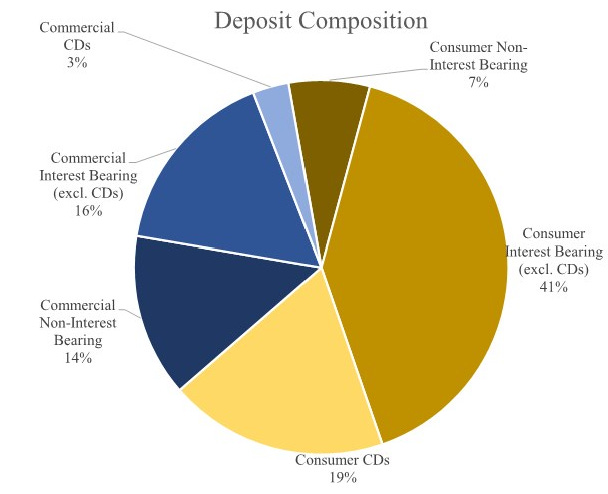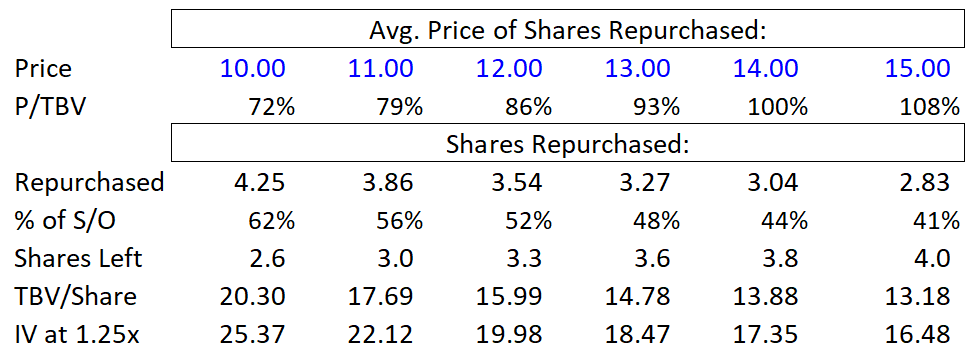This is part two on FFBW Inc., a thrift conversion from early 2020 which I highlighted on an old blog of mine. If you haven’t read that initial write-up yet, I would suggest you start there. Part 1 is available here.
Reading my old write-up, a couple of things jump out:
Share prices of thrift conversions can often languish. FFBW was my first investment in a thrift conversion and nothing drives this home better than experience. In my initial write-up, I noted FFBW traded around 0.7x TBV. One theory of mine was that data providers hadn’t recognized the additional capital from the second step conversion, the implication being FFBW might re-rate once the demutualization was digested by others. Well, fast forward ~18 months and FFBW currently trades at 0.84x TBV. Improvement, but not what I would call a noticeable re-rating. Turns out, few care about subscale, micro-cap thrift conversions. It will be interesting to see what happens with the price as the bank surpasses its second year anniversary and heads towards the three year mark when it can officially be sold to potential suitors.
Covid losses I envisioned haven’t materialized to date. In Spring 2020, I assumed net charge-offs (loan losses) would rise materially (an opinion I figured applied to most banks, not just FFBW). This hasn’t really come to fruition. FFBW’s NCO rate of 25bps YTD isn’t exactly a number I feared at the time of writing. Of course, there was a ton of government stimulus and the CARES Act made it so modified loans weren’t recognized as troubled debt restructurings (TDRs) etc. In short, it’s a good reminder of why predicting the future is so difficult/impossible.
The thesis largely boiled down to management staying in their lane and executing on what I like to call “the conversion playbook”. To simplify, this means prudently expanding the in-market loan portfolio, maintaining asset quality, right-sizing the balance sheet via share repurchases (when it makes sense) or dividend payouts, and smartly deploying capital in M&A activity.
Execution and the original thesis are largely intact. Management has executed the above “conversion playbook” in a manner I largely applaud. The only question is deciding what returns going forward might look like.
Acquisition of Mitchell Bank
On December 30th, 2020, FFBW closed on the acquisition of Mitchell Bank. FFBW paid $5 million in cash for $61.7 million in assets and $56.7 million in liabilities, including $45.6 million in cash and investments, $14.3 million in loans and $56.6 million in deposits. Going back to our lesson on core deposit premiums, I peg this at essentially no premium to core deposits (($5m - $5m) / ($56.6m x 96%)). However, my notes from speaking with CEO Ed Schaefer identify a stated core deposit premium of 1.7%. The implication I think would be that not all of Mitchell Bank’s equity was tangible equity. Either way, FFBW did not appear to overpay by any means! In fact, it looks like a good deal.
Mitchell Bank was really a two branch acquisition, one of which was subsequently closed. The remaining branch is pretty neat building in Milwaukee. Because the Mitchell Bank branch is near FFBW’s Bay View branch, plans call for one of the two to be closed (correction for my misunderstanding after clarification from management).
In part 1, I noted FFBW’s weak deposit franchise (45% core deposits) as one of my negatives. By acquiring Mitchell Bank, FFBW gained access to a sticky customer base that had a 96% core deposit ratio. As reader Corpus Colussus noted a few weeks back, core deposits typically come from price-insensitive customers and are valued because they enable the bank to cross-sell other products, making the customers potentially even more profitable to the bank. FFBW took a huge step toward correcting the lack of core deposits with the Mitchell Bank acquisition and now has a 78% core deposit ratio. As a result, the bank has allowed more expensive CDs to roll of the books which helps lower interest expenses and increase profitability. It can still improve the ratio of non-interest bearing deposits from 21% and hopefully will given an increased emphasis on commercial lending under Schaefer’s stewardship.
Share Repurchases
In February 2021, FFBW announced a 10% share repurchase program. I love this! Standard convention often dictates a thrift repurchase up to 5% of shares outstanding upon their one year anniversary. But FFBW has good asset quality, a relatively small market, and is over-capitalized so why not magnify the accretive buybacks? Well, management (and the board of directors) have done just that right off the bat. FFBW completed the initial 10% buyback in August 2021 and followed it up with a second repurchase program for another 10% of shares outstanding. As of November 2nd, outstanding shares of 6.86m are down 11% vs. YE20. With plenty of capital (FFBW TCE ratio is still 27% as of 3Q21), I suspect the share count will continue to drop precipitously, especially at current valuations or lower. To date, all repurchases have been at a discount to tangible book value. Fantastic!
New CFO
Steve Wierschem joined FFBW in August 2020. He spent nearly 14 years at PricewaterCoopers in the audit practice of financial services and also holds a MBA from University of Wisconsin, Madison. Steve was reportedly brought on to better assist with underwriting acquisitions for the inorganic part of FFBW’s growth strategy. The Mitchell Bank acquisition was after all a trial run of sorts at acquiring/integrating another bank for the FFBW team.
Returns to Date & Returns Looking Forward
I think Ed Schaefer and his team have stuck to, and executed the conversion playbook brilliantly so far. If you purchased FFBW back in Spring of 2020 near the price of $8.75, one would be up around 34%, or an IRR of 21% assuming an 18 month hold period. Of course, most things in the market seem to be up at least as much in the same timeframe, but I’d argue you also weren’t speculating or taking on an excessive amount of risk to generate that return either.
Going forward, I think FFBW should be worth a core deposit premium of at least 5% to an acquirer. That would equate to a current per share value of $15.35 and likely closer to $15.50+ depending on how many shares have been repurchased in 4Q21. On the upper end, you could probably make the case that FFBW could be sold at a 10% core deposit premium or 1.25x TBV multiple, either of which would be close to ~$17.50/share. As opposed to NECB, which only recently completed its second-step conversion, I suspect we could also see quicker action towards those price targets since FFBW is only a little more than a year out from its three year anniversary. Using those two estimates, here is a table of prospective IRRs from today’s $11.70 share price:
Certainly doesn’t look terrible to me unless it drags out to years four or five. There is another interesting aspect of an over-capitalized thrift repurchasing shares. Assuming the share price stays low enough, it’s TBV/share should continue to grow without doing anything other than accretive buybacks. Just for fun, I’ve built the below tables which show the amount of shares FFBW could theoretically repurchase at various prices if it were to use all its excess capital (call it some $40+ million) to normalize its equity capital to a still conservative 15% of assets.
Of course, any growth of the loan portfolio in the coming years would mean FFBW’s excess capital available for repurchases would decline so it’s not necessarily practical. Circularity also begins to enter the equation. A large enough repurchase would likely move the stock price up making future repurchases occur at higher valuations. Finally, other obstacles such as low float likely wouldn’t allow such significant buybacks in the first place, but it’s fun to tinker with the numbers. What it does demonstrate is that the longer the share price languishes at discounts to TBV, the better off long-term shareholders should ultimately be if the company continues repurchasing shares.
This exercise leads me to believe it wouldn’t be crazy for FFBW to be worth $18.50-$20.00 per share in a best case scenario (the above tables also doesn’t include any future earnings generated by FFBW which would be added to the equity base so it is hopefully a realistic upper estimate). A $20 share buyout offer would generate IRRs of 11%+ on any timeframe of 5 years or less.
As a side note, I’d love to hear from other investors how they think about deriving the future value of thrifts that are 1) repurchasing shares as the share price slowly creeps upwards, 2) ideally a takeout target a few years down the line, and 3) are generating minor earnings in the interim. FFBW is only modestly profitable and I don’t expect net income to increase substantially, but it should add a few million dollars each year to existing equity, which adds to its value slowly.
The risks at FFBW remain largely the same…management fails to execute. How this materializes I’m not exactly sure. Perhaps a future acquisition is poorly integrated or too high a price is paid. Additionally, the loan portfolio could experience losses from the shift towards commercial lending some years back, or simply from a recession. As is so often the case in community banks, it largely boils down to asset quality, capital levels, and management. From what I’ve seen so far out of FFBW, the latter two are not really concerns of mine.
I hope you enjoyed this discussion of FFBW. Feel free to comment below and please share this with anyone who may be interested. Thanks for reading!
Disclaimer: I and others I advise are long FFBW shares. This is not investment advice nor a recommendation to buy or sell the security. Everything written is for general educational purposes and I have not considered your specific financial situation.





